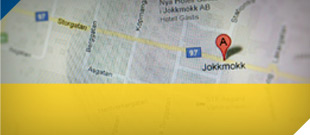Settlers, Lumberjacks and Hydroelectric Dam Builders
In the 18th century the intensive reindeer husbandry was established with migrations in the different seasons. The inhabitants and reindeer from the Sirkas, Tuorpon and the newly established Kaitum Sámi villages migrated in the summer to the mountains, while those of the Jockmock and Sjocksjock villages moved within the forest areas.
The state encouraged homesteaders to colonize the area. By-laws in the "Lappmarksplakatet" of 1695 regulated the relationship between the Sámi and the settlers. The settlers were to dedicate themselves to agriculture and animal husbandry and thus not encroach on the Sámi livelihood. In reality agriculture in the Lappish territories was very limited. At best barley could be grown and later on potatoes when they came to Sweden. The settlers, just like the Sámi, were forced to hunt and fish to survive.
In reality, though, it was only when intensive forestry which supplied the growing saw mills with raw material at the end of the 19th century and beginning of the 20th , that colonization brought about an increase in population. There was now need for many workers in the forests as loggers and rafters. Many villages were established with housing for lumberjacks and their families. In the winter the men spent their time felling trees and transporting the logs by horse. In the spring, once the ice melted, they floated the logs down the streams and rivers to the saw mills. During the summer and autumn they farmed and made hay. The women took care of the home and farm alone most of the year.
The growing industries in Sweden needed electricity. At the beginning of the 20th century it became economically advantageous to exploit the hydropower in the larger rivers of the north, despite the distance and the difficult conditions due to the long winters. The first hydroelectric power plant on the Lule River, the Pioneer Plant in Porjus, produced electricity beginning in the autumn of 1914 and became the starting point for the development of the Lule River which continued until the 1970s.
The exploitation of hydroelectric power meant big changes for Jokkmokk. For the Sámi it meant that grazing lands, calving areas, settlements and holy places disappeared underwater in the large dam facilities. Many people, both reindeer herders and small farmers left their jobs to work on the hydroelectric plants. Temporary towns such as Harsprånget and Messaure existed for a number of intensive years while dams were being built. When everything was completed, the houses were taken down, sold or moved to another facility.
The law giving industrial freedom from 1846 allowed free trade in time and space. But the winter market continued to gather people from the whole parish. The length of the market was reduced from several weeks to one week, and the market now was more just for trade and barter. Worship services and Laestadian gatherings were still important. Weddings and baptisms were planned for the market time, as well as the bailiff meeting with the Sámi villages to deal with reindeer herding issues. But the king's tax collectors had left the scene.












